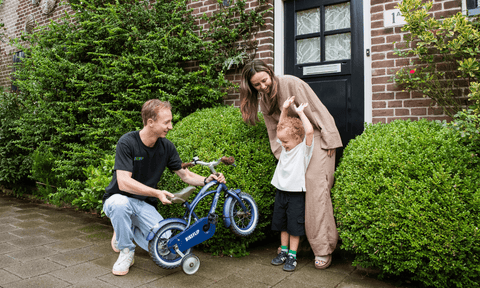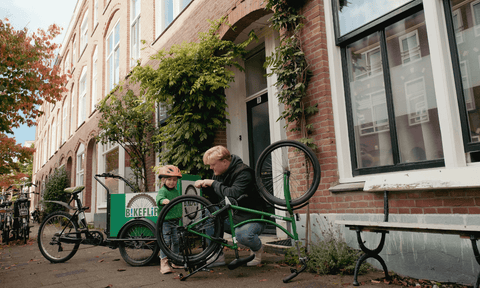The big question many parents have: to use training wheels or not? We at BikeFlip have thought about this for you. Many children start with training wheels , but is that the best way to learn to ride a bike? Or is a balance bike a better option? We have investigated which skills children develop with both methods and what ultimately helps them to learn to ride a bike smoothly and independently.
What We Discovered About Training Wheels
Using training wheels has a number of advantages and disadvantages.
Advantages:
-
Children can quickly start cycling and pedaling.
-
Gives children an instant sense of achievement and self-confidence.
-
Fewer falls in the initial phase.
Disadvantages:
-
Children are not learning the essential skill of balancing.
-
Children often learn an incorrect posture where the weight leans to one side.
-
The transition to cycling without training wheels is often difficult and frustrating.
According to the bike mechanics at BikeFlip, you can also see the disadvantages of training wheels in the wear and tear of bicycles. For example, the training wheels are often crooked when you return them or you can see clear wear and tear on the wheels on one side. They also see that getting off the training wheels is often difficult because children have already learned a bad posture. They then lean to one side when learning to ride a bike without training wheels, which makes balancing extra difficult.
Tips for learning to ride a bike without training wheels
But starting without training wheels can still be quite difficult. Falling a few times can make the bike very scary again. Fortunately, there are some tips to simplify it without training wheels and to get on the road safely.
When learning to ride a bike without training wheels, you can use a handy technique that is gentle on your back and helps your child gradually find balance. You can use a sweater or scarf as a support system. By pulling the arms of the sweater under your child's arms, you create a kind of suspension system with which you can easily keep your child upright during the first attempts at cycling. This has the great advantage that you do not have to bend over yourself, which is much more pleasant for your back, especially if the practice sessions take a little longer. The nice thing about this method is that you gradually have to lift less. You can slowly reduce the support as your child gains confidence and starts to find balance on his or her own. In this way, the child gradually gets the feeling of balancing on the bike, while still experiencing the safety of your support. This gradual transition to cycling independently provides a positive learning experience for both child and parent.
If you start early, you can also choose to use a balance bike first . What we often see is that children learn to ride a bike in a natural way when they start on a balance bike - first balance, then movement. This fits in perfectly with their motor development. We notice that children experience more control because they can always use their feet as safety, which clearly gives them more self-confidence during the learning process. Our experience shows that the transition to a real bike goes surprisingly smoothly for children who have first ridden on a balance bike. Many customers tell us about this smooth transition. As far as we are concerned, the biggest advantage we see is that the learning process is much more enjoyable. We hear from parents that there is less frustration and fewer crying spells during the learning process, which makes cycling more fun for the whole family - both for the children and the parents who experience this milestone with them.
Experiences of others
Many parents wonder whether it is best to teach their children to ride a bike with a balance bike or with training wheels. A balance bike helps children develop their balance and coordination through play, which makes the transition to a regular bike easier, according to Woom . Training wheels, on the other hand, provide stability and help children become familiar with pedaling and steering. However, they do not train the sense of balance, which can make the transition to a bike without training wheels more difficult (Strider Bikes). It is important to consider which method is best suited to the needs and developmental level of your child.
What we advise parents
Based on our own experience and the experiences of others, we recommend the following:
-
Start with a balance bike from 2-3 years old. This teaches children the basics of balance in a natural way.
-
Pay attention to the correct adjustment. With a balance bike, the child should be able to stand with both feet flat on the ground. With the first real bike, the saddle is ideally adjusted so that the feet just touch the ground.
-
If you do choose training wheels , use the following trick: Adjust the training wheels so that they hang about 1 cm above the ground. This should give your child some balance. Be careful that they do not lean to one side so that they rest on one wheel, because then the transition to a bike without training wheels will be more difficult.
-
The right size is crucial. A bike that is too big makes learning to ride unnecessarily difficult and also make sure the saddle is at the right height.
Conclusion
Although training wheels give children a sense of security and stability, it turns out that they do not really contribute to developing balance. This is a crucial skill when cycling. A balance bike helps children to keep their balance in a playful way, which often makes the transition to a regular bike much smoother. Take a good look at the needs of your child when making the choice between a balance bike and training wheels. Of course, you are always welcome to try both by booking a test ride with us . Then we will personally help you with the best first step!



